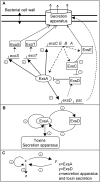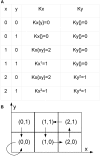Epigenetic acquisition of inducibility of type III cytotoxicity in P. aeruginosa
- PMID: 16734902
- PMCID: PMC1488876
- DOI: 10.1186/1471-2105-7-272
Epigenetic acquisition of inducibility of type III cytotoxicity in P. aeruginosa
Abstract
Background: Pseudomonas aeruginosa, an opportunistic pathogen, is often encountered in chronic lung diseases such as cystic fibrosis or chronic obstructive pneumonia, as well as acute settings like mechanical ventilation acquired pneumonia or neutropenic patients. It is a major cause of mortality and morbidity in these diseases. In lungs, P. aeruginosa settles in a biofilm mode of growth with the secretion of exopolysaccharides in which it is encapsulated, enhancing its antibiotic resistance and contributing to the respiratory deficiency of patients. However, bacteria must first multiply to a high density and display a cytotoxic phenotype to avoid the host's defences. A virulence determinant implicated in this step of infection is the type III secretion system (TTSS), allowing toxin injection directly into host cells. At the beginning of the infection, most strains isolated from patients' lungs possess an inducible TTSS allowing toxins injection or secretion upon in vivo or in vitro activation signals. As the infection persists most of the bacteria permanently loose this capacity, although no mutations have been evidenced. We name "non inducible" this phenotype. As suggested by the presence of a positive feedback circuit in the regulatory network controlling TTSS expression, it may be due to an epigenetic switch allowing heritable phenotypic modifications without genotype's mutations.
Results: Using the generalised logical method, we designed a minimal model of the TTSS regulatory network that could support the epigenetic hypothesis, and studied its dynamics which helped to define a discriminating experimental scenario sufficient to validate the epigenetic hypothesis. A mathematical framework based on formal methods from computer science allowed a rigorous validation and certification of parameters of this model leading to epigenetic behaviour. Then, we demonstrated that a non inducible strain of P. aeruginosa can stably acquire the capacity to be induced by calcium depletion for the TTSS after a short pulse of a regulatory protein. Finally, the increased cytotoxicity of a strain after this epigenetic switch was demonstrated in vivo in an acute pulmonary infection model.
Conclusion: These results may offer new perspectives for therapeutic strategies to prevent lethal infections by P. aeruginosa by reverting the epigenetic inducibility of type III cytotoxicity.
Figures





Similar articles
-
Presence or absence of lipopolysaccharide O antigens affects type III secretion by Pseudomonas aeruginosa.J Bacteriol. 2007 Mar;189(6):2203-9. doi: 10.1128/JB.01839-06. Epub 2007 Jan 5. J Bacteriol. 2007. PMID: 17209027 Free PMC article.
-
Type III secretion phenotypes of Pseudomonas aeruginosa strains change during infection of individuals with cystic fibrosis.J Clin Microbiol. 2004 Nov;42(11):5229-37. doi: 10.1128/JCM.42.11.5229-5237.2004. J Clin Microbiol. 2004. PMID: 15528719 Free PMC article.
-
Epigenesis and dynamic similarity in two regulatory networks in Pseudomonas aeruginosa.Acta Biotheor. 2004;52(4):379-90. doi: 10.1023/B:ACBI.0000046604.18092.a7. Acta Biotheor. 2004. PMID: 15520540
-
Microevolution of Pseudomonas aeruginosa to a chronic pathogen of the cystic fibrosis lung.Curr Top Microbiol Immunol. 2013;358:91-118. doi: 10.1007/82_2011_199. Curr Top Microbiol Immunol. 2013. PMID: 22311171 Review.
-
Pseudomonas aeruginosa chronic colonization in cystic fibrosis patients.Curr Opin Pediatr. 2007 Feb;19(1):83-8. doi: 10.1097/MOP.0b013e3280123a5d. Curr Opin Pediatr. 2007. PMID: 17224667 Review.
Cited by
-
Involvement of a phospholipase C in the hemolytic activity of a clinical strain of Pseudomonas fluorescens.BMC Microbiol. 2008 Oct 30;8:189. doi: 10.1186/1471-2180-8-189. BMC Microbiol. 2008. PMID: 18973676 Free PMC article.
-
Virulence of the Pseudomonas fluorescens clinical strain MFN1032 towards Dictyostelium discoideum and macrophages in relation with type III secretion system.BMC Microbiol. 2012 Sep 29;12:223. doi: 10.1186/1471-2180-12-223. BMC Microbiol. 2012. PMID: 23020706 Free PMC article.
-
Cell-associated hemolysis activity in the clinical strain of Pseudomonas fluorescens MFN1032.BMC Microbiol. 2010 Apr 24;10:124. doi: 10.1186/1471-2180-10-124. BMC Microbiol. 2010. PMID: 20416103 Free PMC article.
-
Optimal epitope composition after antigen screening using a live bacterial delivery vector: application to TRP-2.Bioeng Bugs. 2010 Jan-Feb;1(1):51-60. doi: 10.4161/bbug.1.1.9482. Bioeng Bugs. 2010. PMID: 21327126 Free PMC article.
-
Association of biofilm formation and cytotoxic potential with multidrug resistance in clinical isolates of Pseudomonas aeruginosa.EXCLI J. 2019 Feb 13;18:79-90. eCollection 2019. EXCLI J. 2019. PMID: 30956641 Free PMC article.
References
-
- Govan JR, Harris GS. Pseudomonas aeruginosa and cystic fibrosis: unusual bacterial adaptation and pathogenesis. Microbiol Sci. 1986;3:302–308. - PubMed
Publication types
MeSH terms
Substances
LinkOut - more resources
Full Text Sources
Research Materials

